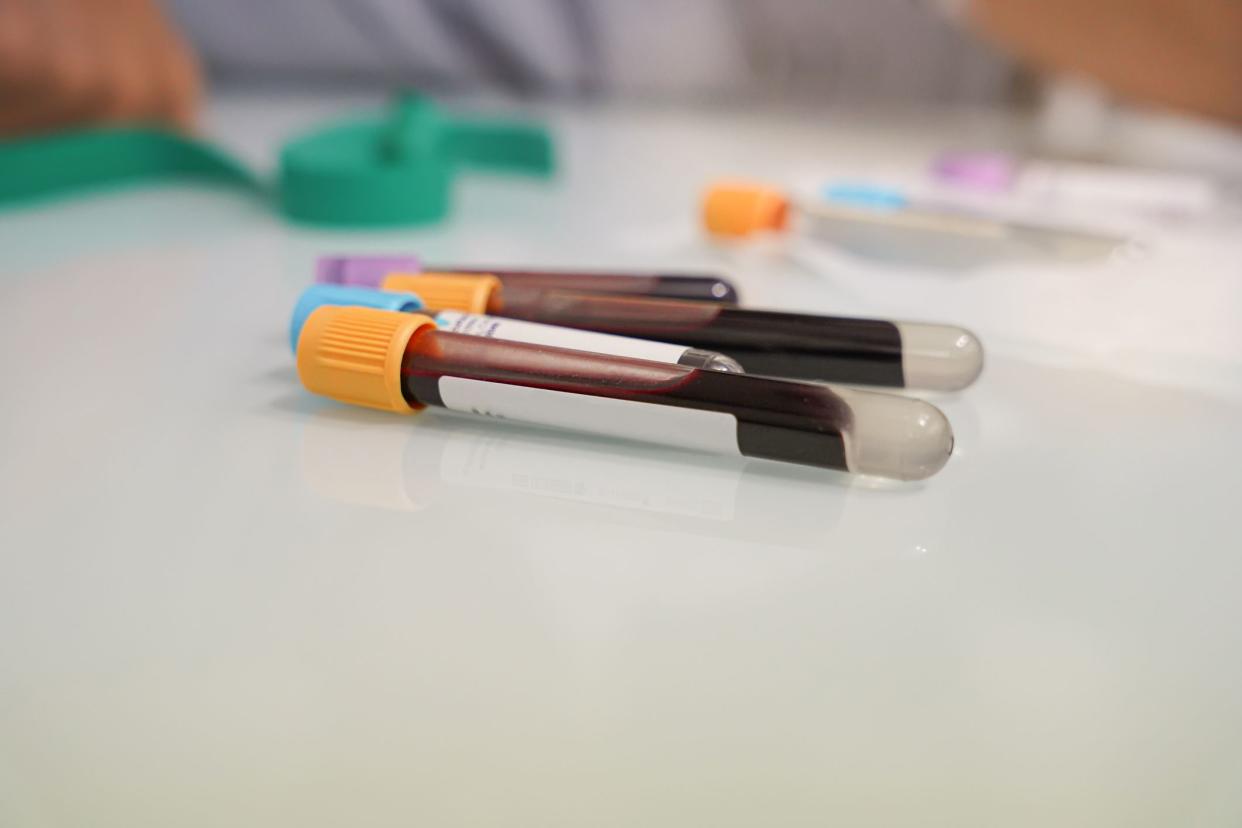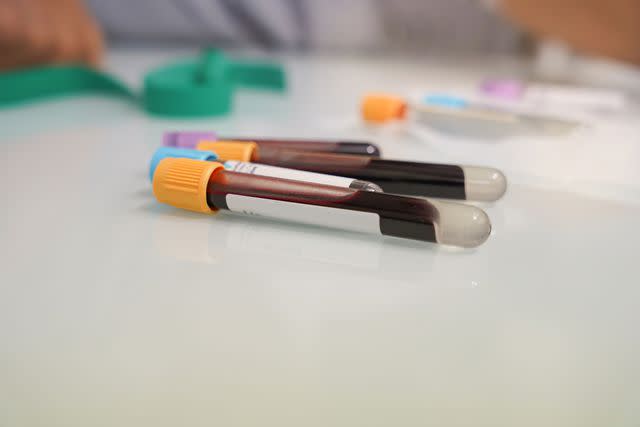Your Guide to the MRT Test for Food Sensitivities

Sheila Alonso / Getty Images
Medically reviewed by Allison Herries, RDN
The Mediator Release Test (MRT) is a type of blood test used to test your body’s reactions to 0ver 170 foods and food additives. It is a patented test from Oxford Biomedical Technologies, Inc.
This article will explore which food sensitivities can be tested, how the MRT test works, what you can expect from testing, how to interpret the results, and the next steps regarding the Lifestyle, Eating, and Performance (LEAP) elimination diet. You’ll also learn what other types of food sensitivity testing may be available.

Sheila Alonso / Getty Images
What Are Food Sensitivities?
The term "food sensitivity" is often used to refer to food intolerances. It is not an established medical diagnosis. For the purposes of this article, a food sensitivity can be thought of as an immune system response to food or a food additive that doesn’t rise to the level of a food allergy, which can be life-threatening.
There are no reliable blood tests to detect a food sensitivity, whereas a food allergy is commonly diagnosed through blood tests that measure immunoglobulin E (IgE) antibodies (blood proteins produced by the immune system to identify and then neutralize foreign substances).
Common food sensitivities include:
Dairy
Peanut
Soy
Wheat
Tree nuts (such as almonds, cashews, pecans, and walnuts)
Shellfish
Fish
Sesame
Learn More: 10 Types of Food Intolerance and Their Symptoms
Food Intolerance
Food intolerances are considered sensitivities to certain foods or substances in those foods. They cause symptoms like digestive upset (bloating, gas, cramping, diarrhea). They do not cause immune system reactions. It’s said that food intolerances are caused by the lack of an enzyme needed to digest certain foods or as a reaction to the naturally occurring compounds in foods or additives.
Learn More: Symptoms of Food Intolerance
Food Allergies
Food allergies are immune system responses to a specific substance in the food consumed. They might be called type 1 sensitivities. Substances that cause an immune reaction are called antigens. Your body goes into immediate fight mode against antigens by producing IgE antibodies.
Symptoms associated with food allergies include breathing problems (which can be life-threatening) and skin reactions like rashes.
Type 2 Sensitivities (Cytotoxic)
Type 2 sensitivities (cytotoxic) refers to a specific antibody response that leads to cell or tissue damage, destruction, and cell behavior dysfunction. Reactions of this type have a gradual rather than immediate onset.
Type 3 Sensitivities (Immune Complex)
The third type of sensitivity usually occurs after at least one exposure to a substance. The immune response here is different because it leads to an antigen-antibody aggregate or bond called immune complexes. Immune complexes remain even after the substance has left the body. They can be found in skin, joints, and vessels, and can cause tissue damage, like in rheumatoid arthritis.
How Does the MRT Test Work?
In an MRT, you’ll have blood drawn, likely from your arm. This blood sample will be tested for a reaction to common foods associated with sensitivities.
MRT works by exposing a small amount of your white blood cells and plasma to a certain food or food additive and then monitoring for changes in the blood composition.
If a food or additive causes a sensitivity reaction, pro-inflammatory mediators are released by the white blood cells, causing the white blood cells to shrink and the blood plasma volume to increase. This measurement of inflammatory mediators is used to determine sensitivity to that food substance.
The MRT is a modification of the antigen leukocyte antibody (ALCAT) test. These tests have been described as unproven and unstandardized by an expert panel. There is a lack of peer-reviewed research to establish the validity of these tests. More research is needed to determine the effectiveness of these types of tests.
Do Not Use MRT Testing for a Food Allergy
MRT testing has yet to be proven to be valid and reliable. If you suspect you have a food allergy, you should see an allergist first to rule out an IgE-related food allergy, especially since a food allergy can be life-threatening. The Academy of Nutrition and Dietetics, an organization of food and nutrition professionals, has released a practice paper stating that MRT should not be used for testing for food allergies.
What to Expect
If you’ve decided to get the MRT test, you will need to reach out to a certified LEAP therapist. You may also decide to contact Oxford Biomedical Technologies directly for testing options. Either way, you can expect a blood test to be administered.
The MRT test may occur in a travel lab, mobile blood draw clinic, an independent draw site, or at the Oxford clinic in Miami, Florida. Locations can be found on the company website. You can expect a notification when your test results are ready for review.
Interpreting the Results
Interpreting the results of the MRT is fairly straightforward. The foods and food additives will be shown in a diagram like a bar graph. They may be colored green, yellow, red, or in shades of gray if printed. There will be three sections the bar could flow into and include:
Green: Unreactive or safe foods
Yellow: Foods that should be set aside for three to six months
Red: Foods that should be avoided for as long as three to four years
LEAP Elimination Diet
The LEAP elimination diet is based on the results of your MRT test. The goal of the LEAP diet is to calm the immune system. Like other elimination diets, the LEAP diet has different phases.
During the first phase, yellow and red foods are eliminated for a period of time to reduce inflammation and achieve a reduction in symptoms. Once this is achieved, eliminated foods or food groups are slowly reintroduced into the diet one at a time while closely monitoring for the return of symptoms. The goal during this phase is to identify more “safe” foods or safe amounts of food.
The final phase includes continuing to expand and “challenge” yellow and red foods to build a balanced diet that also calms the immune system.
Learn More: How Food Intolerance Is Treated
Other Types of Food Sensitivity Testing
Other types of food sensitivity testing can include skin prick or skin scratch tests. These are performed by an allergy specialist, who may also perform a blood test for IgE antibodies to specific foods. An allergist will review your symptoms, your history of food reactions, and your results from an elimination diet or oral food challenge to diagnose a food allergy.
Blood tests for immunoglobulin G (IgG) antibodies are common for diagnosing exposure to bacterial or viral infections. but they are unproven in testing for food allergies or sensitivities. Unlike IgE antibodies, the presence of food-specific IgG antibodies is not associated with a food allergy or sensitivity. There’s a lack of evidence to support making dietary changes based on these tests.
It’s important to note that no single test can give you what is often marketed, sometimes including a clear answer and solution about food sensitivity or allergy.
If you have questions about the MRT test or LEAP diet, consider speaking with a healthcare provider about your current symptoms first. Some symptoms may be associated with other health conditions. Your healthcare provider may be able to help you determine the cause of your symptoms and refer you to a dietitian for further assistance.
Summary
An MRT test is a blood test used for assessing your white blood cells’ reactions to common food allergens and additives. Its purpose is to determine which foods are creating a reaction leading to symptoms. The test is patented but considered unproven by medical and scientific experts.
This test must be conducted by a certified LEAP therapist. Afterward, you can expect information on which foods to consume and which to avoid (i.e., a LEAP diet).
Frequently Asked Questions
How accurate is the MRT test?
The MRT test is a patented product created by Oxford Biotechnology Technologies, Inc. It is marketed as the most complete blood test for food sensitivities.
The MRT test is unproven and unstandardized, according to a committee of the National Institute of Allergy and Infectious Diseases (NIAID), a division of the National Institutes of Health.
How long does it take to get the results of an MRT test?
Result times vary based on test location. Consider asking in advance or at the appointment time at the draw location site when you can reasonably expect to receive results.
How much does the MRT test cost?
MRT test costs vary based on where you get the test done and how many foods you are testing for. Prices are subject to change at any time, according to the company website.

